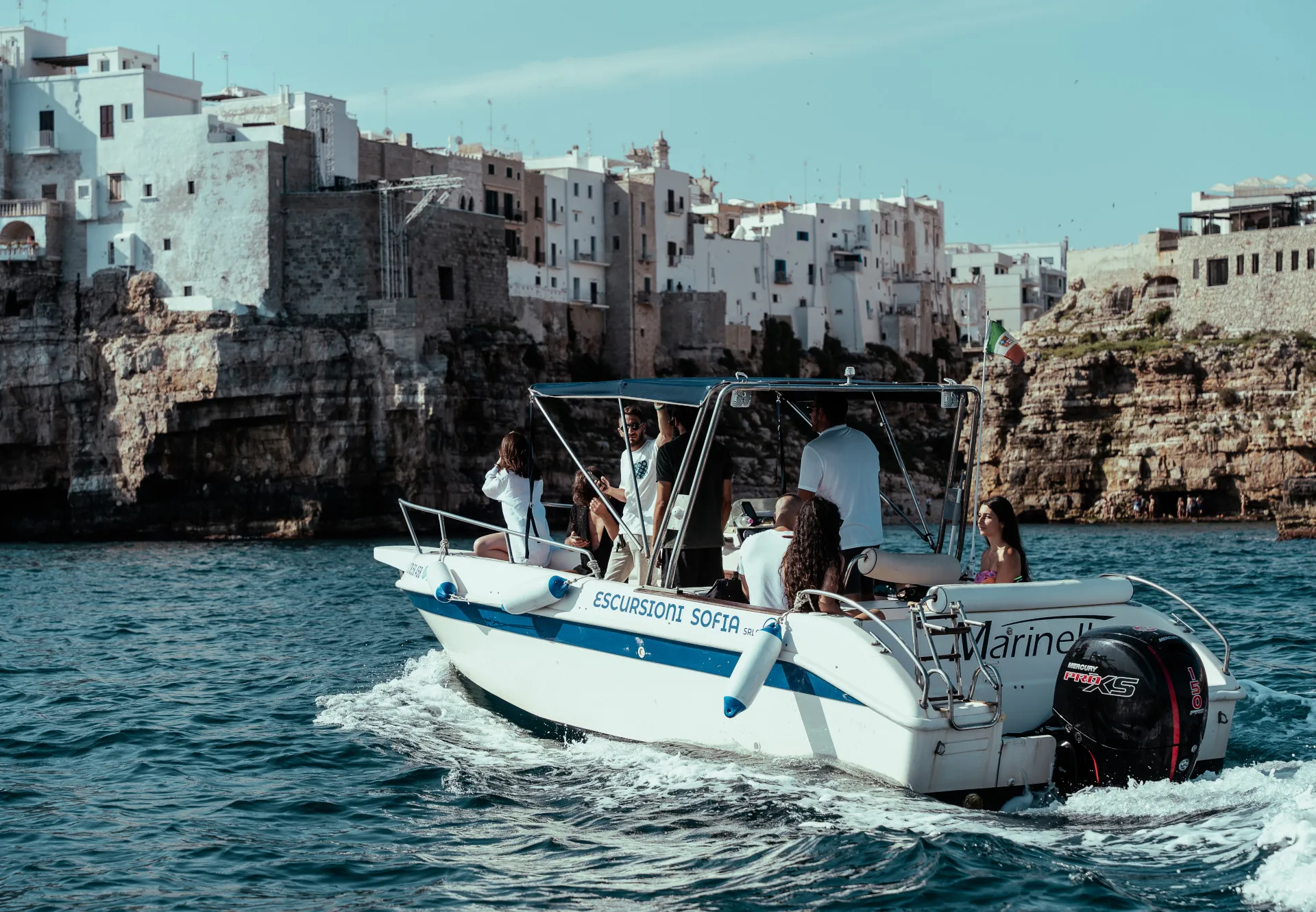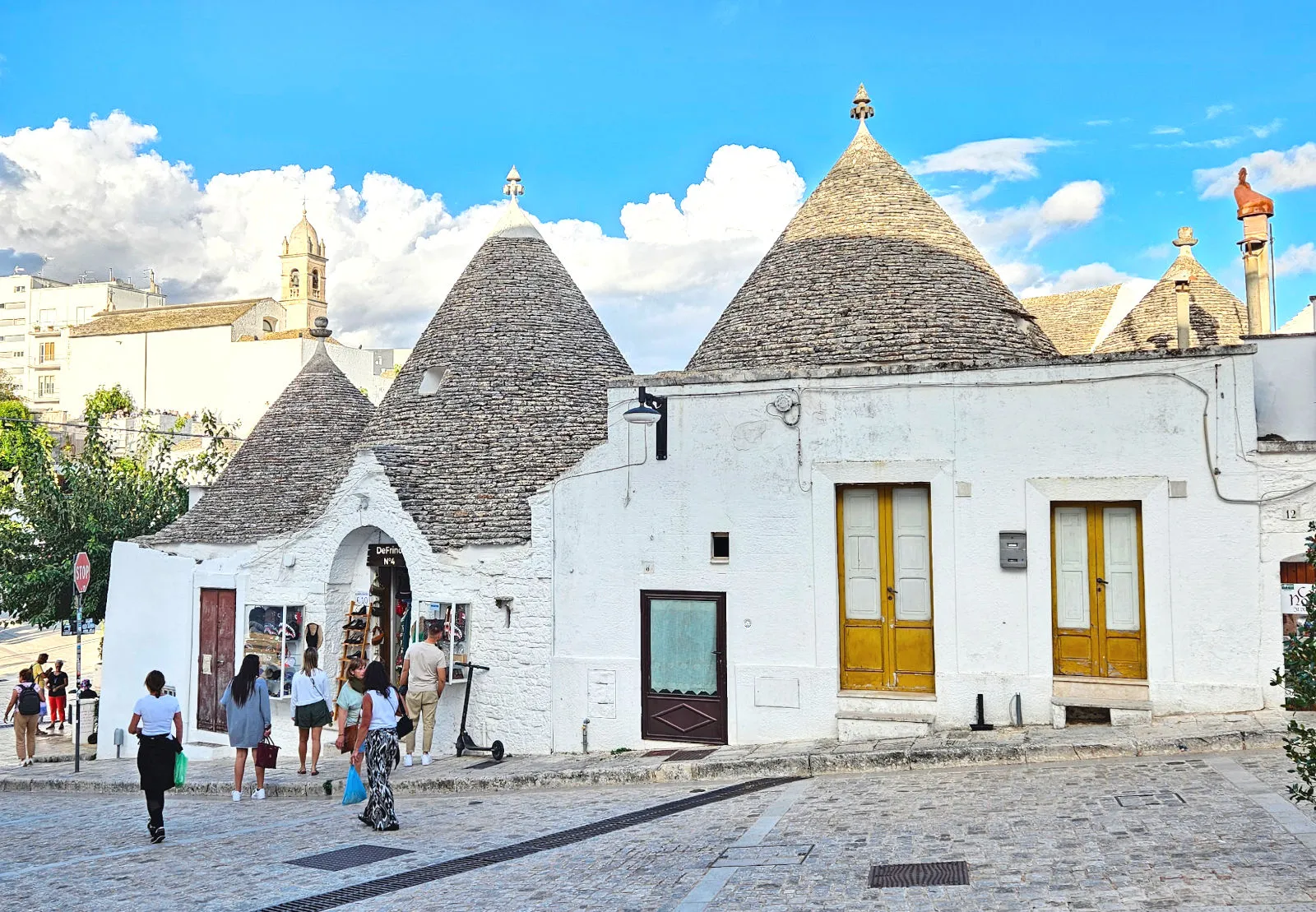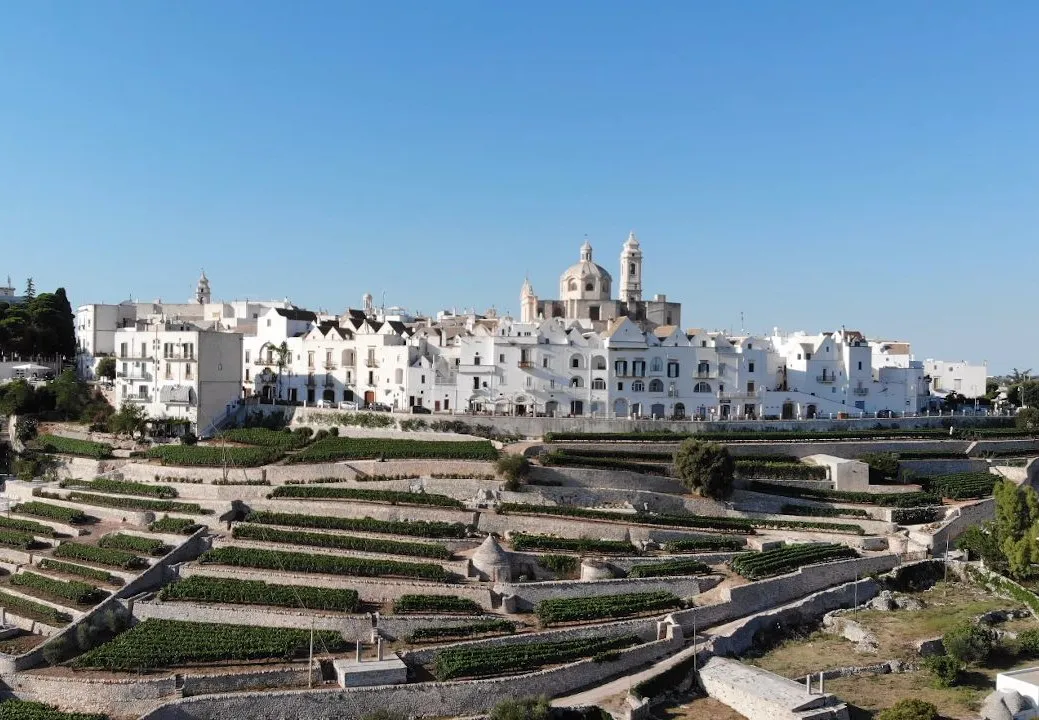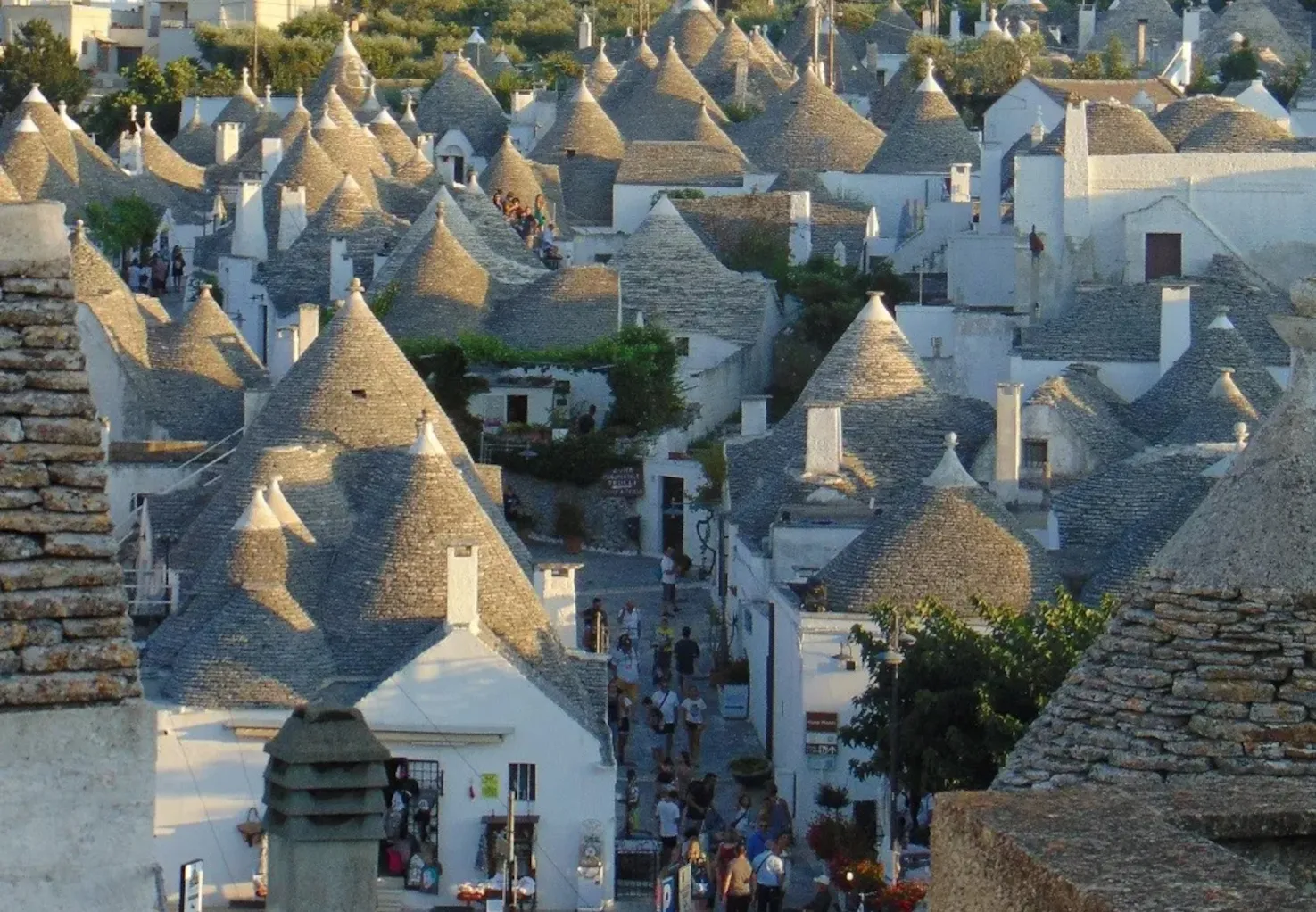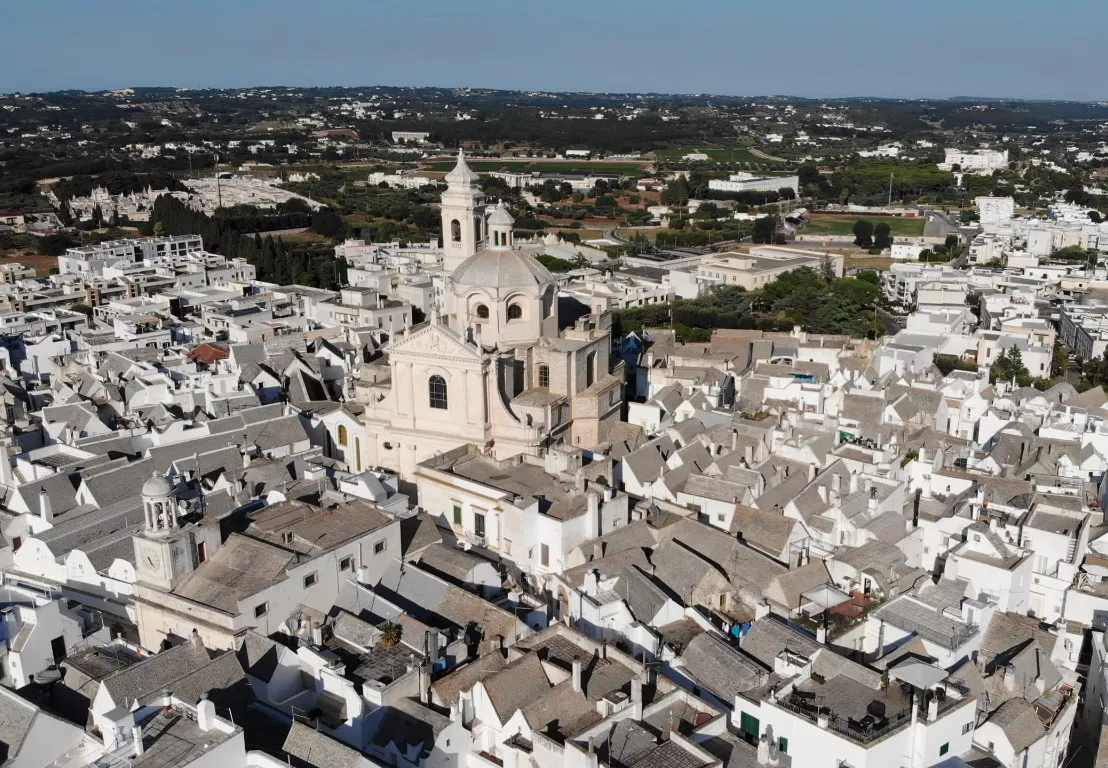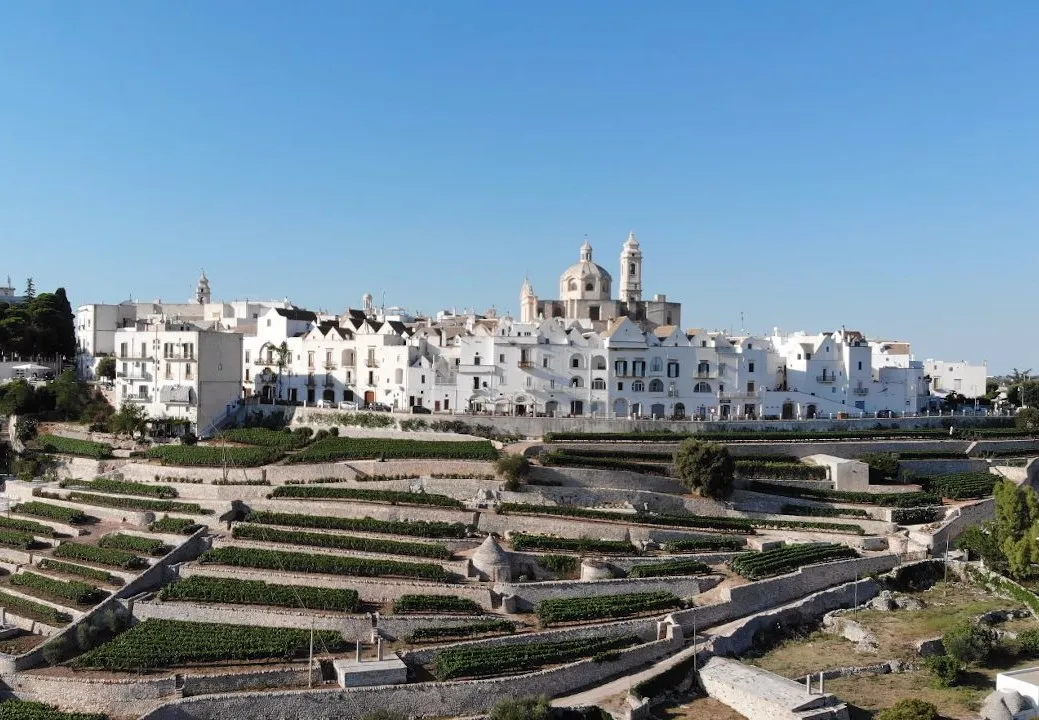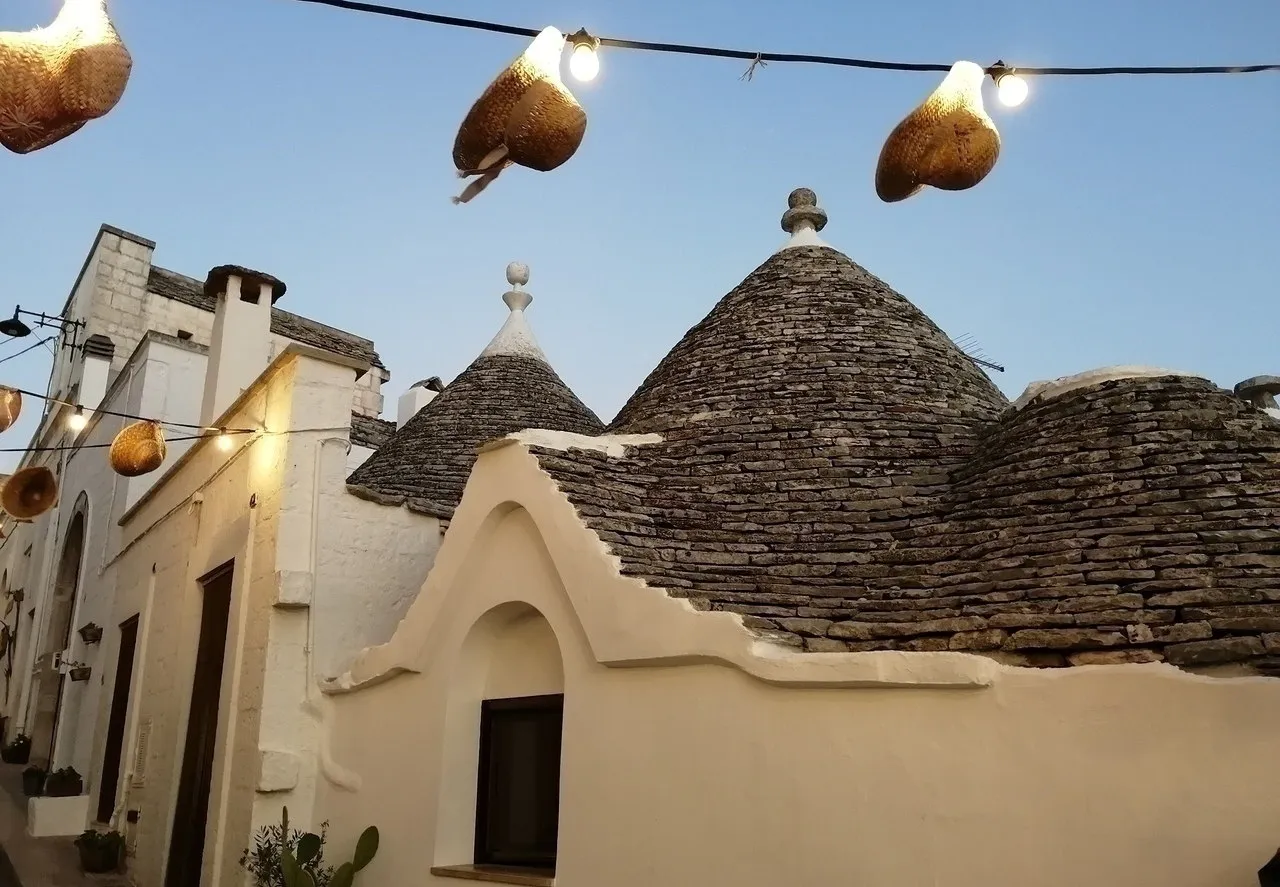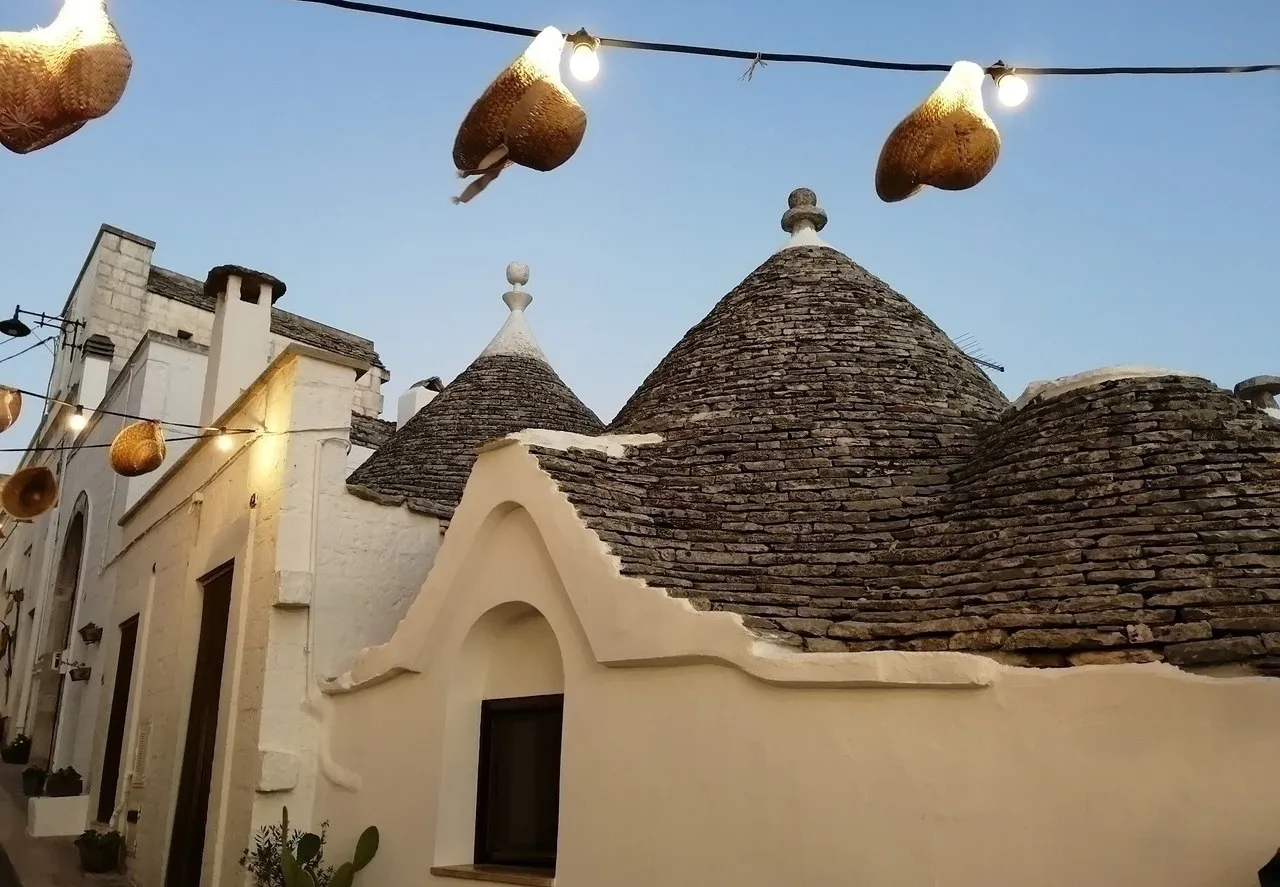Alberobello: what to do and what to see in the homeland of the Trulli
Updated at: 25-01-2025
How this content can help you:
- You will discover the history and origins of the trulli of Alberobello, a UNESCO World Heritage site.
- You will visit iconic places such as Rione Monti and Aia Piccola, neighborhoods of the trulli.
- You will admire the Trullo Sovrano, the only two-story trullo, and the mysterious Trullo Siamese.
- You will explore the Church of Sant'Antonio, the only church in the world shaped like a trullo.
- You will delve into the legends and mysterious symbols on the roofs of the trulli.
- You will experience the authentic atmosphere of the Valle d'Itria and its traditions.
- You will learn about special events such as Alberobello at Christmas.
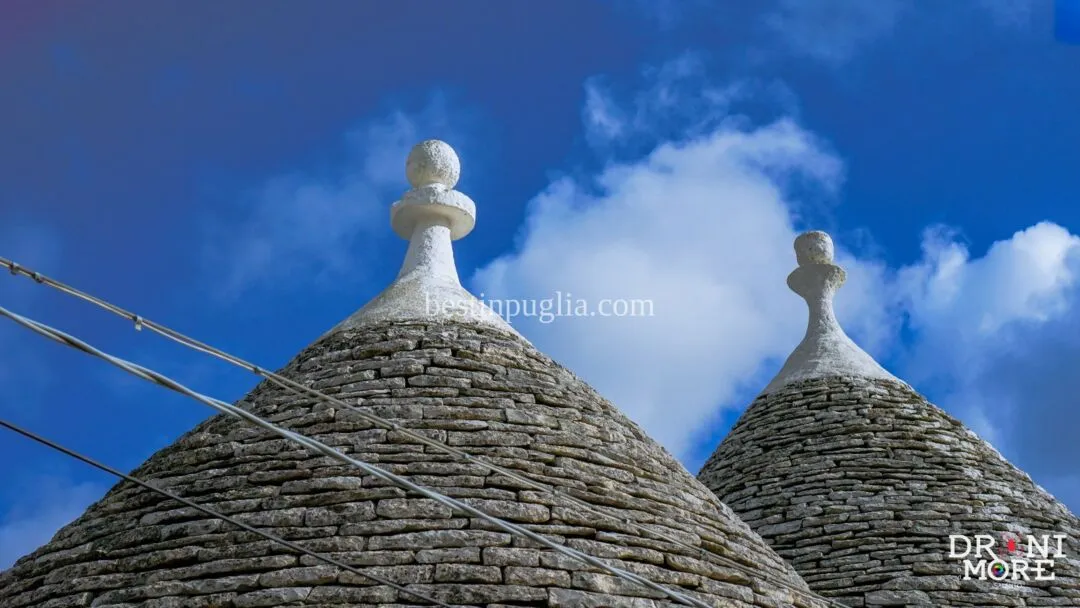
What to see in Alberobello in one day?
Our advice on what to see in Alberobello if you only have one day is to enjoy a walk in the city center, in the Rione Monti and Aia Piccola neighborhoods, admiring the Trulli and the surrounding landscape. During your stops you can taste wines and typical local products in one of the characteristic restaurants.
Halfway between Bari and Taranto, on the hills of the Itria Valley that rise between the Adriatic Sea and the Ionian Sea, stands the characteristic and evocative village of Alberobello.
Alberobello is a municipality in the province of Bari located on the hills of the Itria Valley, in the center of the Land of the Trulli. Alberobello is famous throughout the world for its historic center made of Trulli, the typical buildings with conical roofs built in dry stone, and is therefore considered the Capital of the Trulli. Entire neighborhoods of Alberobello, including the Rione Monti and Aia Piccola, are entirely made up of the characteristic Trulli.
The Trulli are particular constructions spread throughout the lower Puglia that have been declared a UNESCO World Heritage Site since 1996.
During your holiday in the Itria Valley you cannot miss a visit to the village of Alberobello, considered by the majority of visitors one of the most evocative places in Puglia.
Things to do in Alberobello
Despite its small size, Alberobello offers numerous activities that enchant every visitor. This picturesque village, famous for its trulli, can be explored in different ways. Let yourself be guided by the colors and scents of its streets or follow some tips to make the most of your time in Alberobello.
Whether you prefer to get lost in the alleys, following the colors and scents, or explore its most iconic sites, there is always something to do.
These are some of the things we recommend to do in Alberobello:
- Explore the most iconic Trulli
- Visit to the Museo del Territorio
- Reach the Trullo Church of Sant'Antonio
- Discover the Trulli neighborhoods
- Shopping and Souvenirs
Explore the most iconic Trulli
Visit the two neighborhoods of Alberobello entirely made up of trulli, the Rione Monti and the Aia Piccola. Among the most evocative trulli to visit, wandering around the historic center, there is the Trullo Sovrano, the only two-story one today used as a house-museum. We also recommend a visit to the Trullo Church of Sant'Antonio, the only church in the world built with the same characteristics as the trulli, and the Trullo Siamese, whose peculiarity lies in the double shape of the roof, a continuous double cone.
Many of the trulli of Alberobello are shops or private homes, but you can visit some inside to admire their structure. Some of these can be visited and offer a fascinating journey through time.
€ 45.5
€ 354.9
Visit to the Museo del Territorio
To learn more about the history and evolution of these extraordinary constructions, don't miss the Museo del Territorio, a single complex of 15 trulli connected to each other. Here you can see up close how construction techniques have changed over the centuries.
Many of the trulli are accessible to the public, but only the Museo del Territorio offers a complete view of the architectural evolution of the city. Here, the two-story section with the tall, narrow façade, crowned by a triangular tympanum, represents the most recent constructions.
Reach the Trullo Church of Sant'Antonio
Walking along Via Monte San Michele, reach the top of the hill and admire the suggestive Trullo Church of Sant'Antonio.
You will live a rare architectural experience, being the only church in the world built with this technique. Built in 1927, this church with conical domes and a white façade represents a true architectural gem, unmissable for those visiting the city.
Alberobello and the most beautiful districts to visit
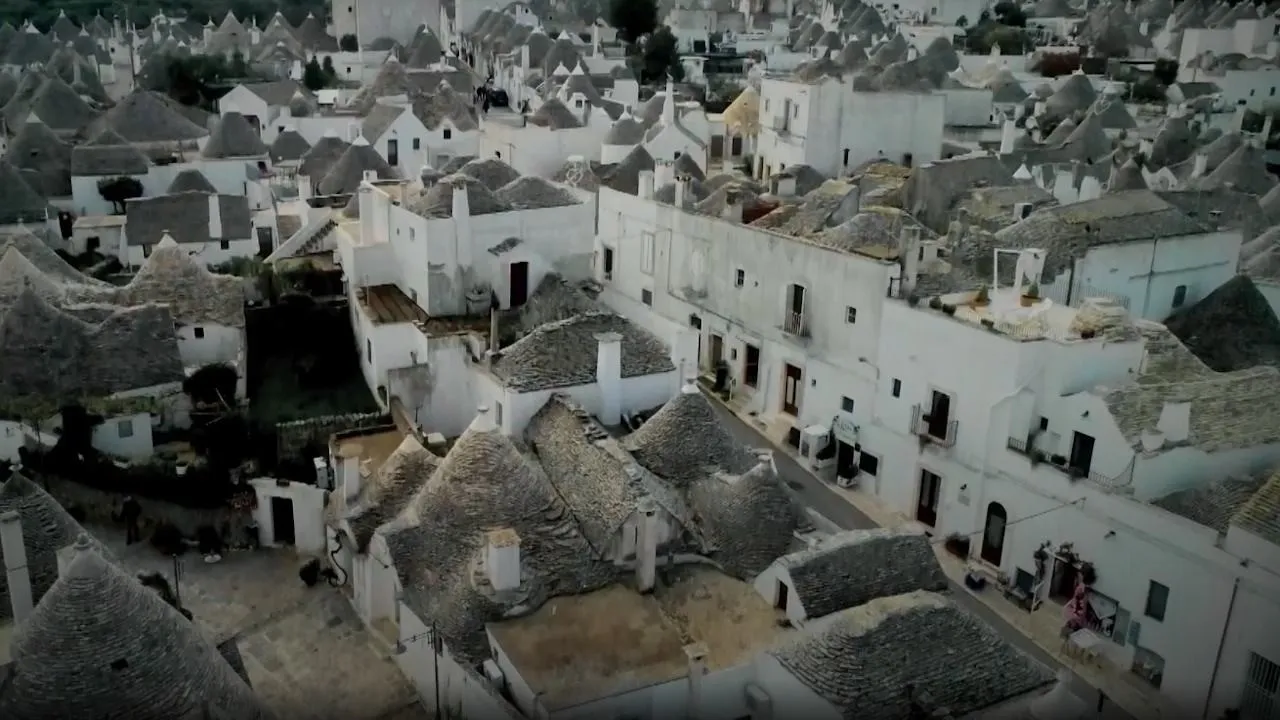
The name Alberobello derives from the Latin "Sylva Alboris Belli" which literally means Forest of the War Tree.
The same name refers to very ancient times, in which the whole area was covered by very dense vegetation, in part still visible as soon as you reach the heights of its territory when you go up from the coast to reach the municipality of Alberobello.
Alberobello is divided into villages and some of these are almost completely made up of the characteristic dry stone buildings, still inhabited by the citizens of the municipality.
The most characteristic neighborhoods of Alberobello are:
- Aia Piccola district
- Monti district
€ 354.9
Aia Piccola district
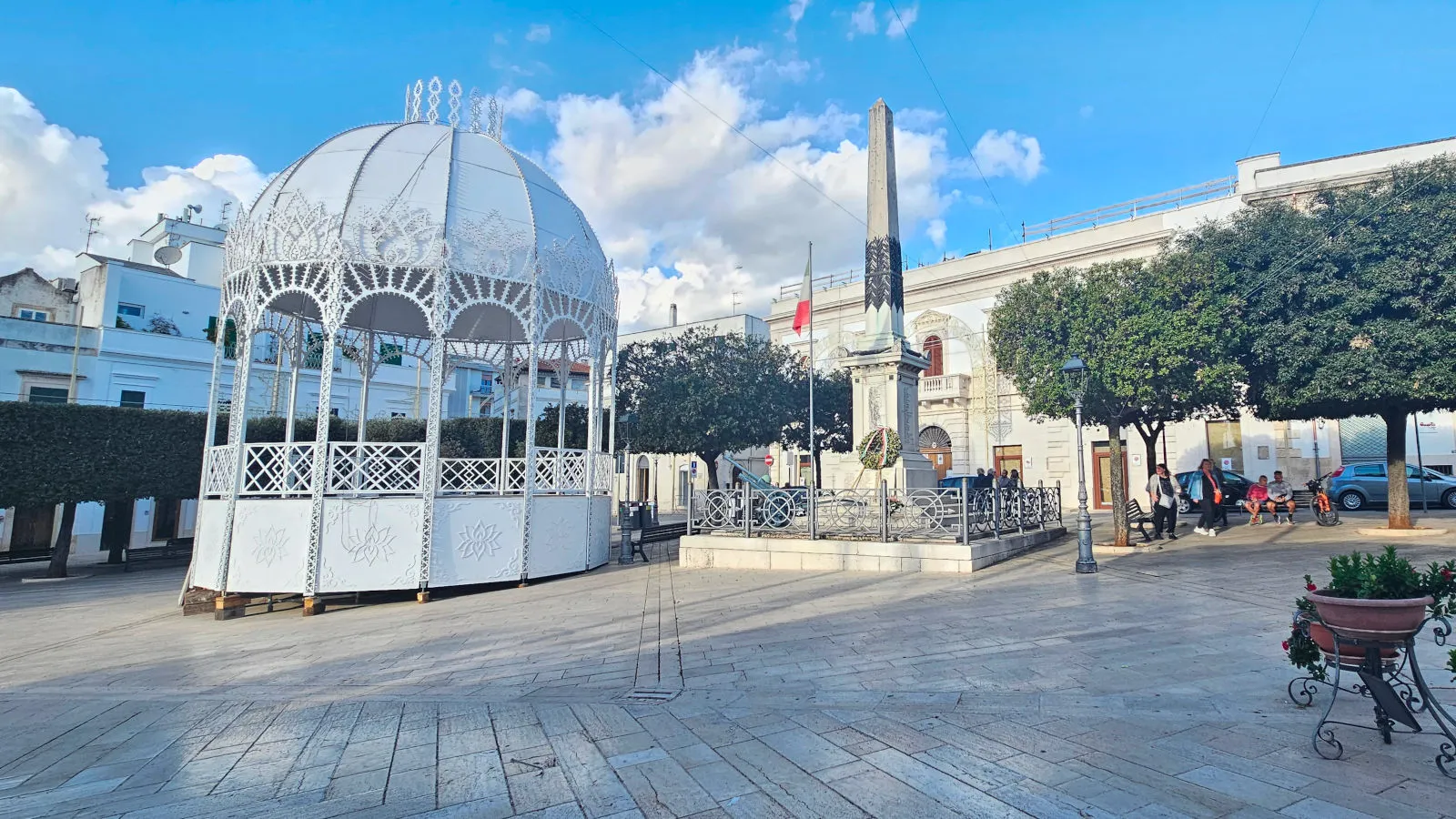
One of the most characteristic areas of Alberobello is the Aia piccola district.
Walking through the Aia Piccola district you will be fascinated and fascinated by the streets and alleys that divide the 400 Trulli that make up the area.
One of the most beautiful areas to visit in the Aia Piccola district is the Belvedere of Santa Lucia from which you can enjoy the wonderful panorama overlooking the Trulli and the historic center.
Monti district
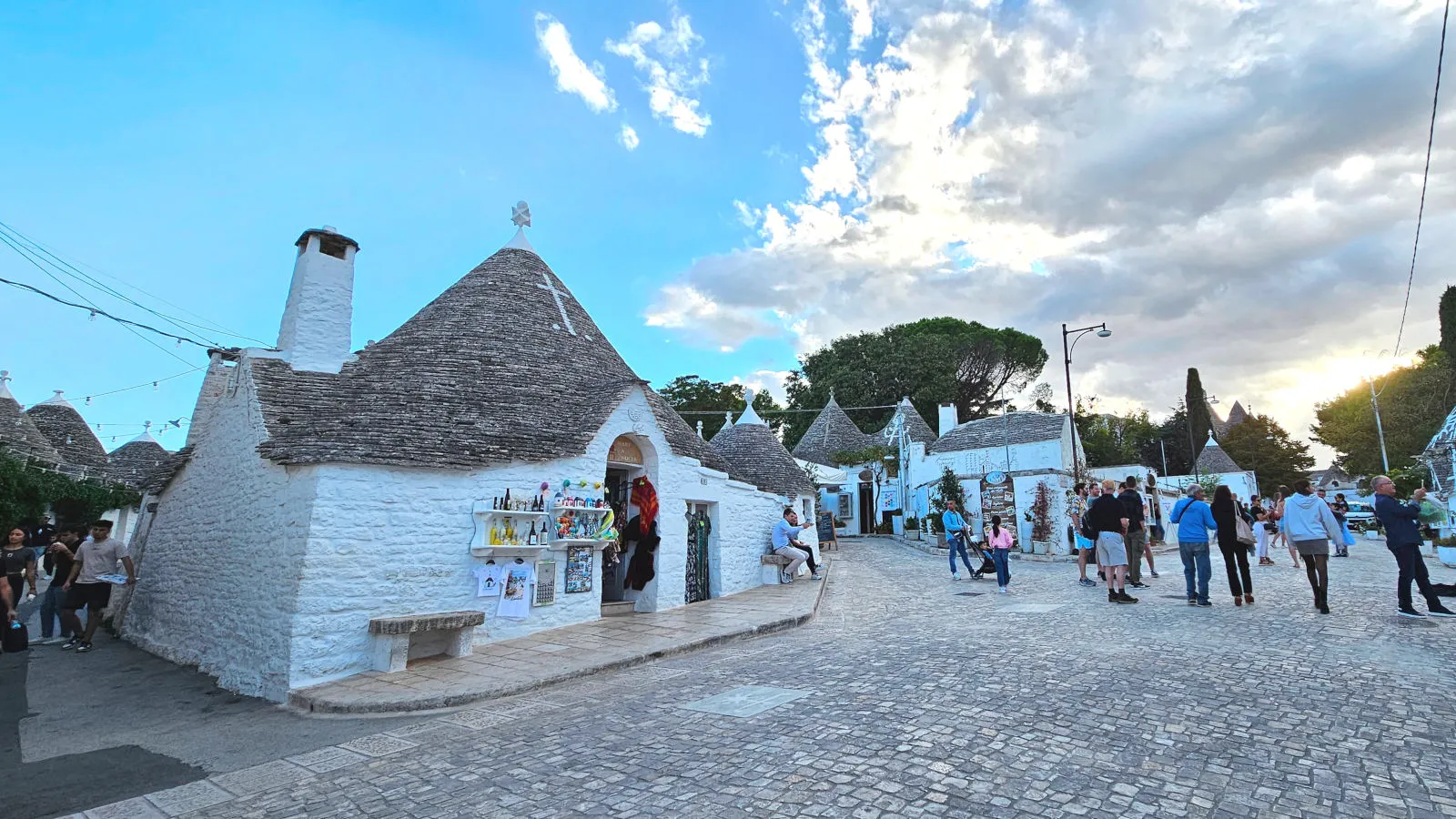
A second important village of Alberobello is the Rione Monti which is one of the oldest neighborhoods in the municipality.
The Rione Monti is the most commercial and touristic area of the city, where you will find various souvenir shops and refreshment points.
If you haven't had the opportunity or the time to be able to stay in a Trullo in Alberobello then we recommend that you visit the Rione Monti.
Here, in fact, visitors have the unique opportunity to take advantage of the tourist or catering activities present, and therefore the opportunity to visit and admire the interior of a Trullo with its freestanding stone structure and its characteristic furnishings.
Alberobello what to see and what to do
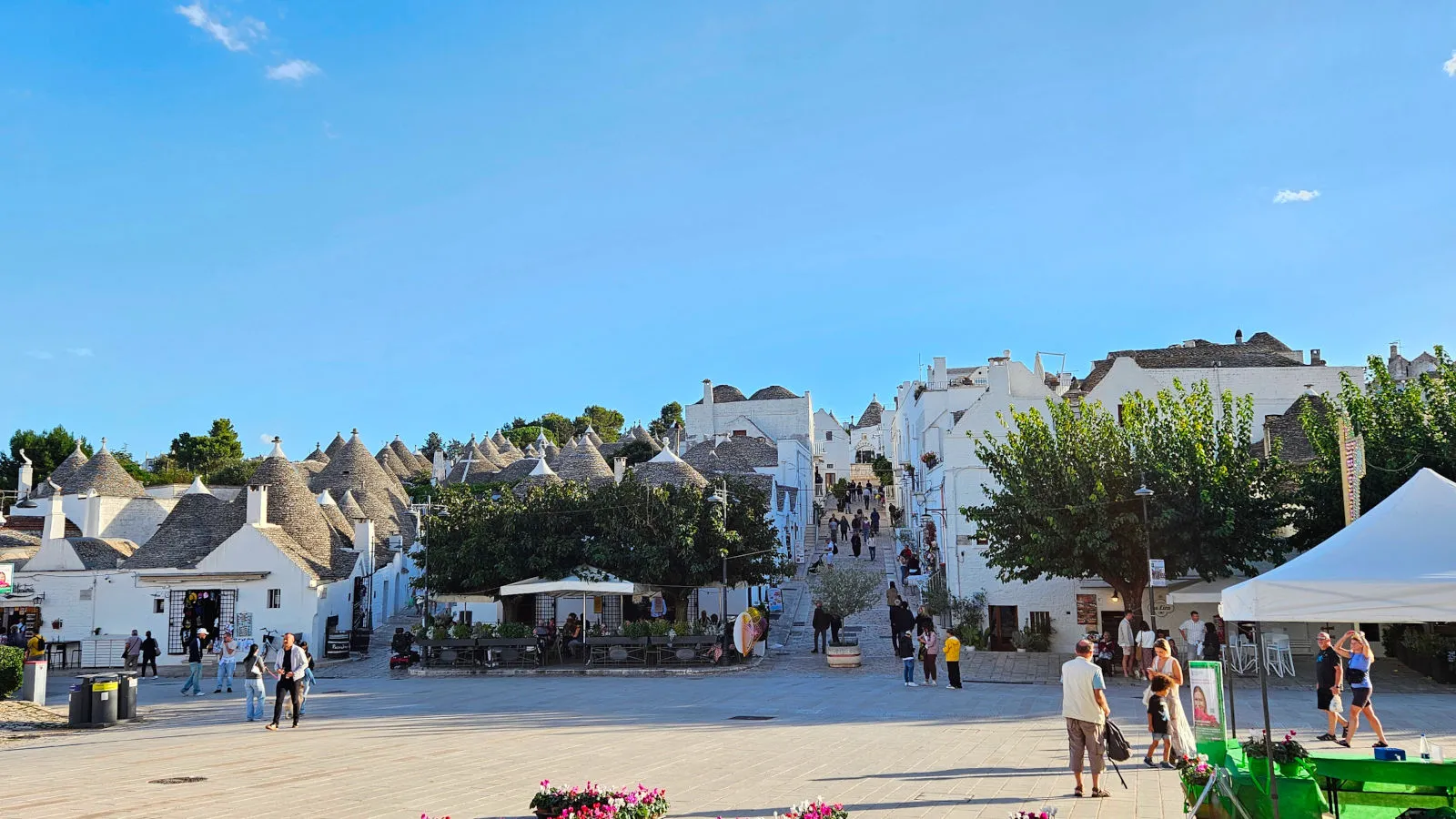
Here are our tips on the most beautiful places to see in Alberobello:
- Trullo Sovrano
- Trullo Siamese
- Belvedere Santa Lucia
- Trullo Church of Sant'Antonio
Trullo Sovrano
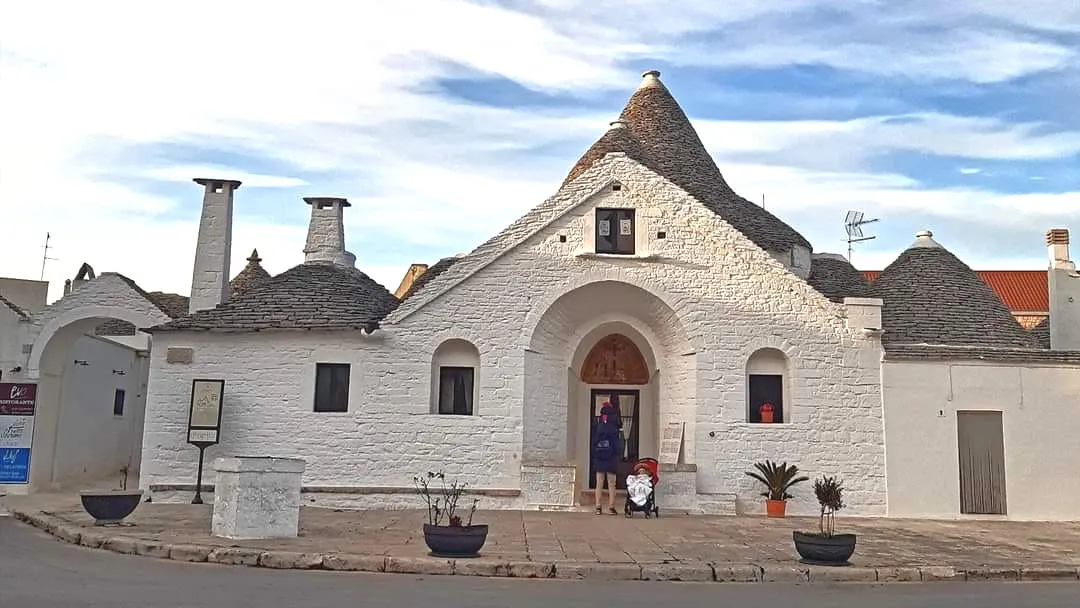
The first stop to do is the Trullo Sovrano, built in the second half of the eighteenth century, in Piazza Sacramento.
The Trullo Sovrano was so called because it has a height of 14 meters, and today it is one of the most important attractions of Alberobello.
A curiosity is that the Trullo Sovrano was built with the use of mortar, thus violating the Aragonese edict of the Prammatica de Baronibus.
In 1923 it became a National Monument and from 1994 it was used as a House Museum.
If you visit Alberobello in the summer, the sovereign Trullo hosts various kinds of shows.
Trullo Siamese
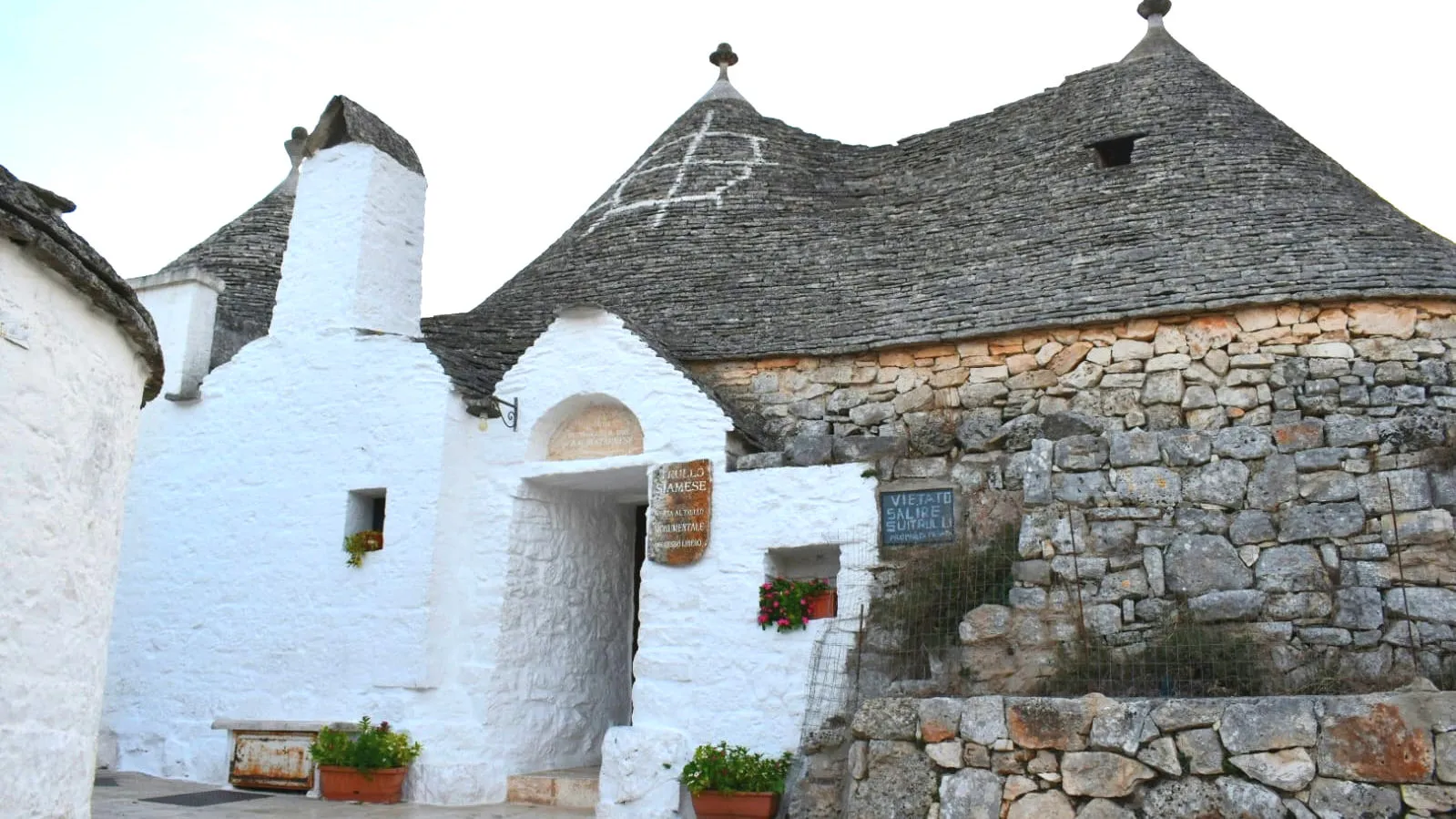
Another stone house that deserves your attention is the Siamese Trullo.
It is a double shaped structure, without windows. The trulli are adjacent forming a single house but with different entrances.
Also internally separate rooms can be distinguished but connected by a door.
Belvedere of Santa Lucia
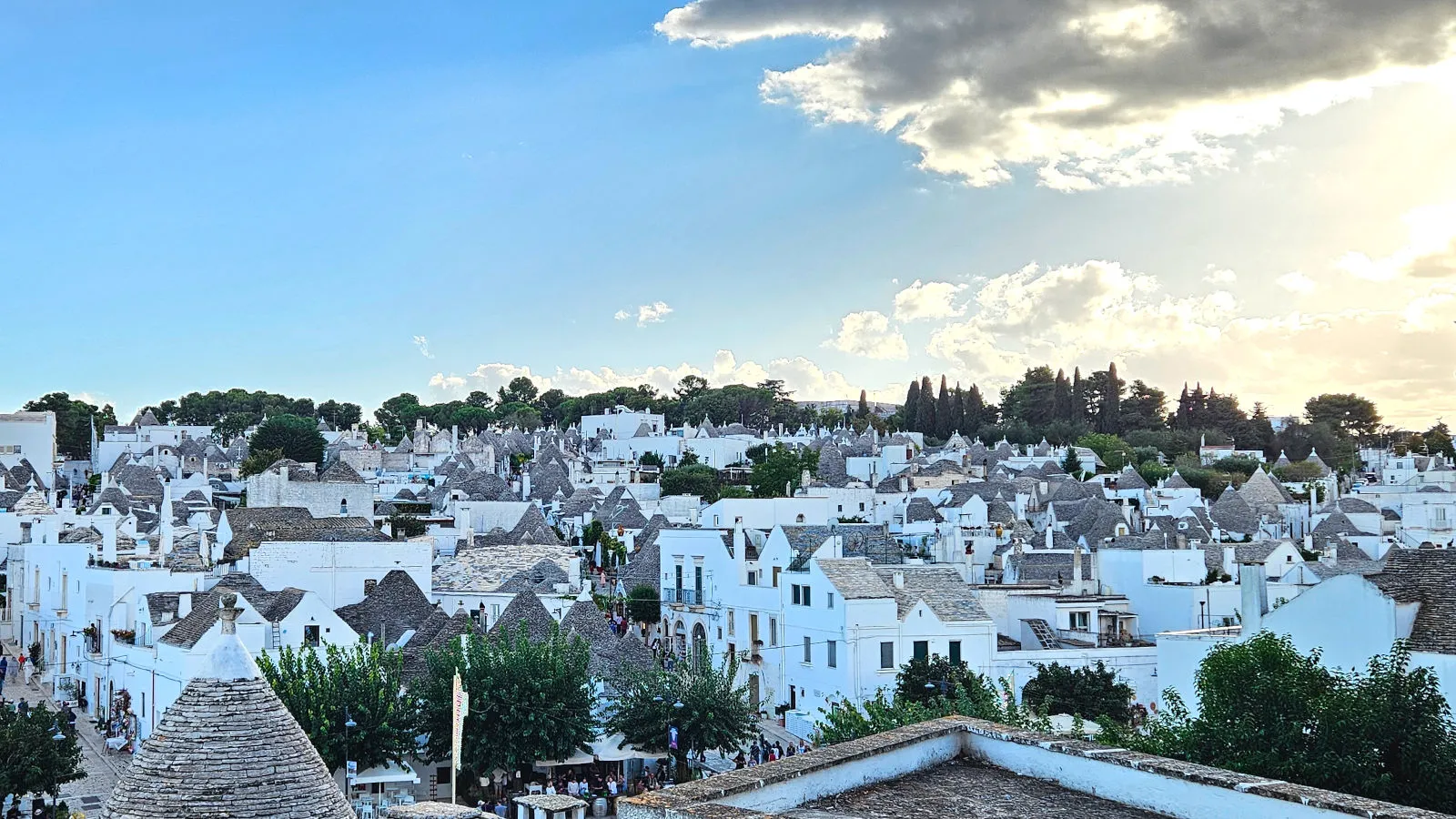
Among the things to see in Alberobello, we certainly recommend that visitors strolling through the historic center, in the oldest quarter of Alberobello or the Rione Aia, stop at Belvedere Santa Lucia.
From the belvedere, visitors can indeed admire the wonder of the village and take beautiful photos.
If you want to enrich your visit to Alberobello, we recommend that you book a night in a real trullo to live an absolutely unique experience.
Trullo Church of Sant'Antonio
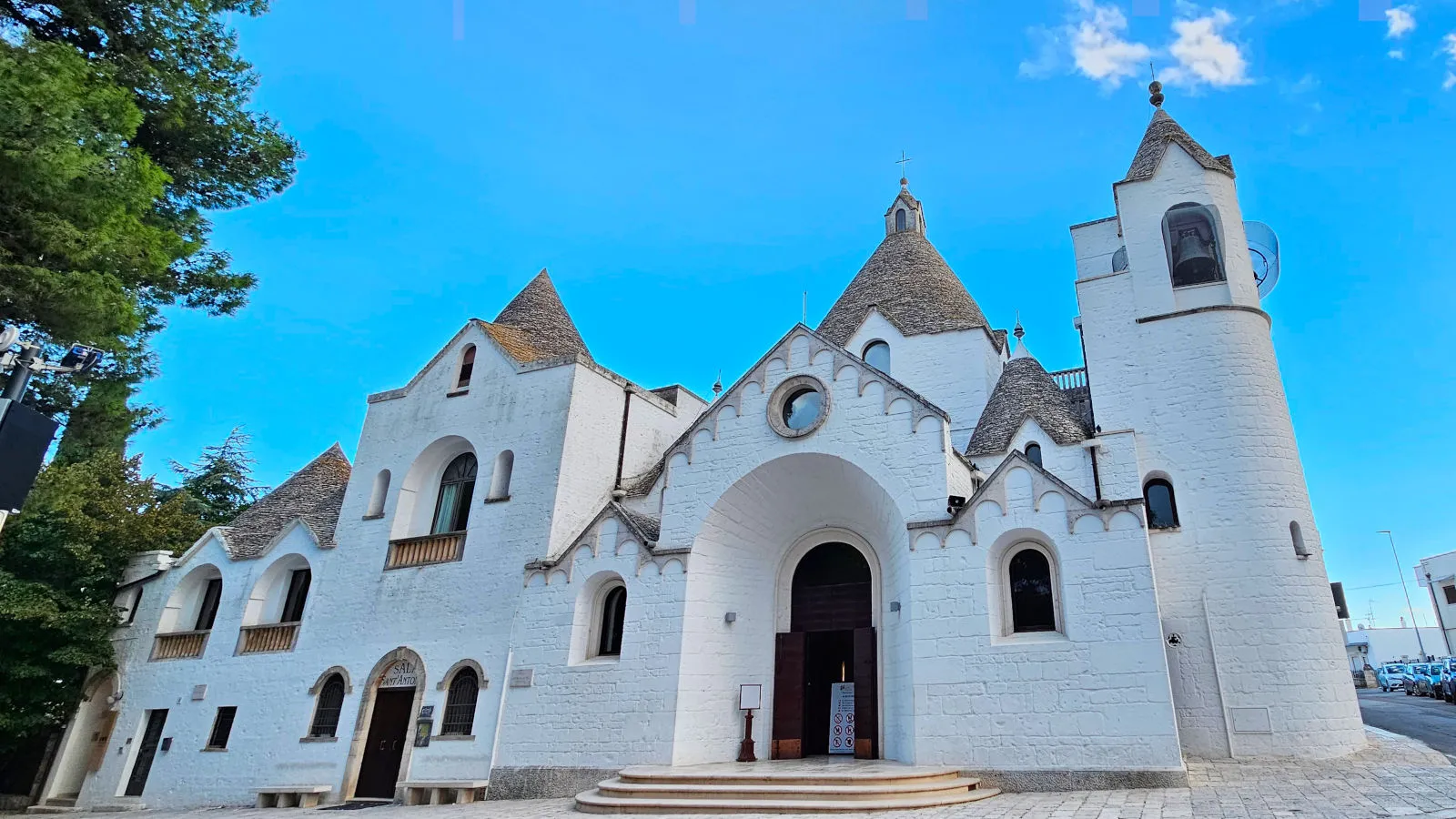
The church of Sant'Antonio is a trullo-shaped building built in a few months in 1927 following the traditional shapes of the surrounding buildings.
It was built on the highest part of the Rione Monti and was commissioned by the client as a symbol of struggle against the other religions that were advancing in the territory.
Its construction aroused, together with other buildings in the Rione Monti, many disputes and alarms on the part of the citizens due to the progressive loss of the traditional building canons in the district.
The church has a wide staircase surmounted by a rose window. The staircase leads into the space in the shape of a Greek cross that can be perceived from the outside by observing the large external cone flanked by the sail-shaped roofs of the side chapels. At the end of one of the chapels the bell tower was raised.
Alberobello: the modern history of the Trulli
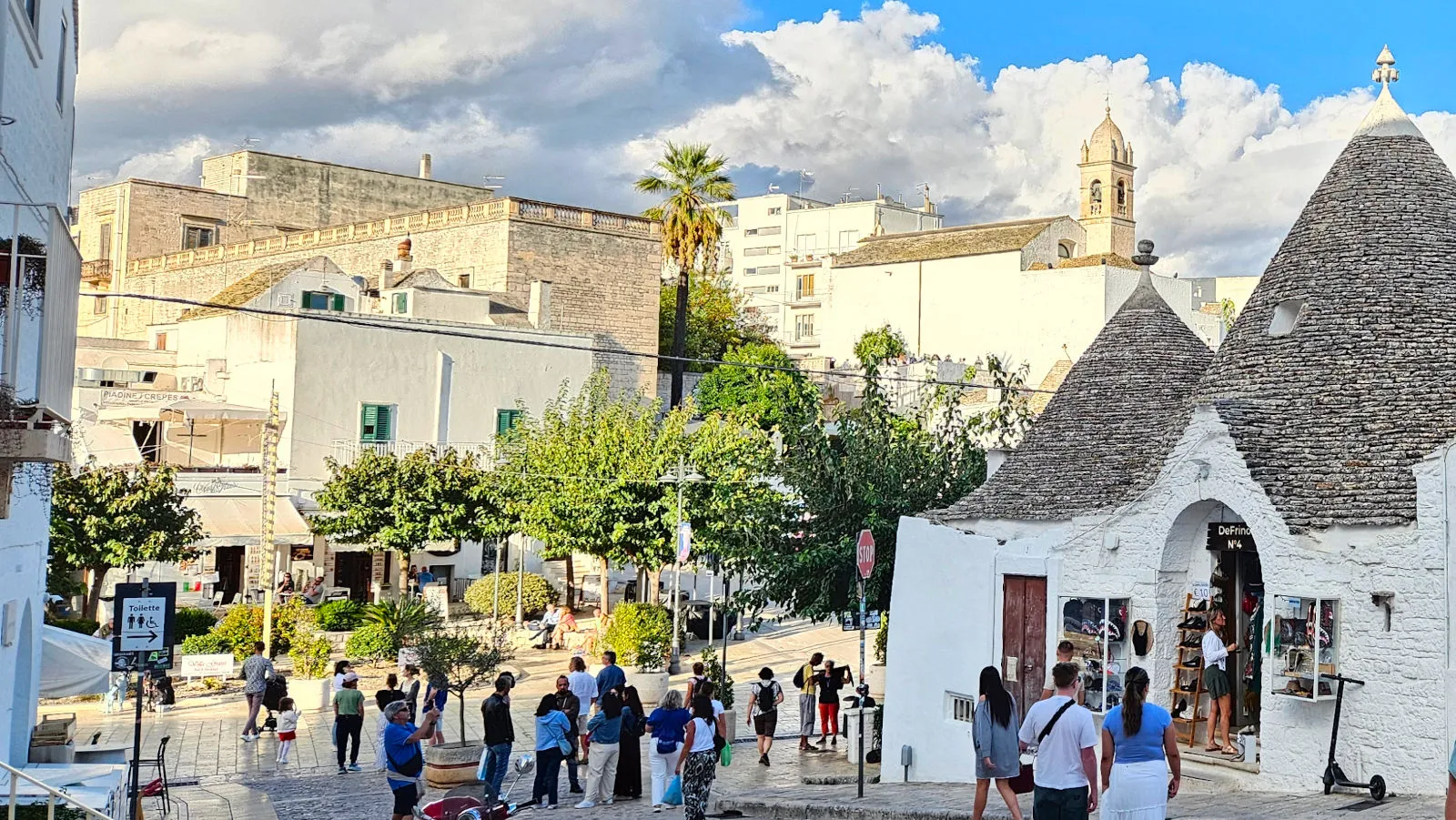
The construction of the trulli is a millenary tradition in the Apulian territory but the construction of the trulli in Alberobello, as we know them today, is linked to an edict promulgated at the end of the fifteenth century, the "Prammatica de Baronibus".
The edict was issued by the Aragonese rulers to regulate the rights exercised by the barons of the time especially with respect to the civic communities and towns scattered over their territories.
At the time of the promulgation of the "Prammatica", in 1466, the Aragonese had the need to limit the baronial power which had previously been given the power to freely build urban or rural settlements from which to obtain taxes.
In fact, that era was marked by the contrast of powers between the Barons and the Aragonese royal house, a relationship in which the Barons were strong in increasingly vast feudal possessions while the Aragonese crown was engaged in the difficult recognition of the succession rights of King Alfonso.
Precisely to put a stop to the equal relationship of the Barons with the representatives of the Aragonese crown, the royal house wanted to impose the payment of a tax for each new urban settlement within their kingdom.
The Counts of Conversano, the owners of the territories of the Itria Valley at the time, imposed the construction of the houses only with stones in order to be able to circumvent the edict promulgated by the Aragonese.
The landowners thought of circumventing the edict by having the peasants who worked their land build buildings in dry stone or without the aid of concrete.
In fact, they considered these buildings precarious and therefore exempt from tax.
When the visit by the Aragonese tax collectors was expected, who thought they would be able to demonstrate the construction of residential centers in their possessions and therefore demand tributes from the barons for this, the barons ordered the demolition of the stone structures to request their reconstruction immediately after the departure of the debt collectors.
The best compromise for the re-construction of the Trulli with dry stone walls, by the farmers who lived there, was to give it a round shape, with a false domed roof composed of overlapping stone circles.
Alberobello, heritage of Italy to visit and heritage for the world to see
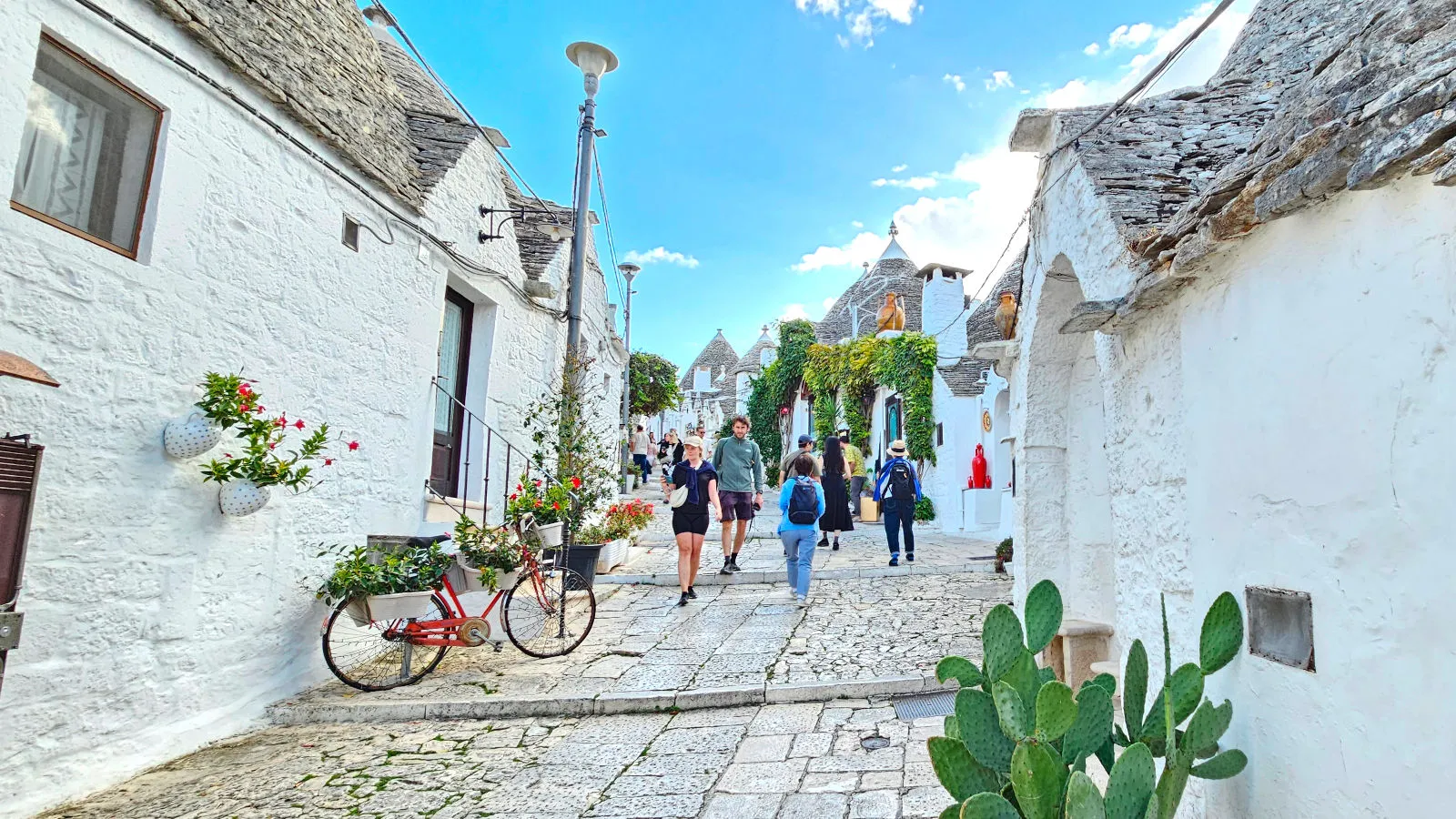
Going on holiday to Alberobello is an unforgettable experience for the visitor who will find himself immersed in an ancient and mysterious landscape.
A trip to Alberobello brings back the mind and imagination of visitors of many centuries back, allowing them to live today the experiences and habits that traditionally the inhabitants of Alberobello have lived.
Alberobello is an extraordinary town with conical roof houses called trulli which have very ancient origins, so ancient that these houses have become a national monument and later a UNESCO World Heritage Site.
The inhabitants usually mark the heraldic sign of the family on the hand-carved stone plates, which form the cone-shaped roof of each room of their homes.
Each trullo ends with a pinnacle, a symbol of protection or good wishes.
Alberobello: tradition as a lifestyle
Visitors on holiday in Alberobello will be able to realize how much the territory and traditions are part of the social fabric and lifestyles of the citizens of Alberobello, as well as of most of the agricultural territories of Puglia.
Traditionally, the natural landscape of Alberobello accords with the rhythms and needs of the figures closed between the white walls blinded by the sun, that is the peasants, who today inherit and cultivate the same traditions as the peasants of the past.
The land gave enough to live on but it was necessary to work it with patience and tenacity.
Even if they lived modestly from agriculture, life was laborious and happy.
In the air you can still breathe a pleasant sense of cleanliness, nobility and composure of life that is never denied.
All these characteristics give the surprised visitor, even today, the sense of discovery.
How Trulli are built: ancient knowledge handed down from father to son
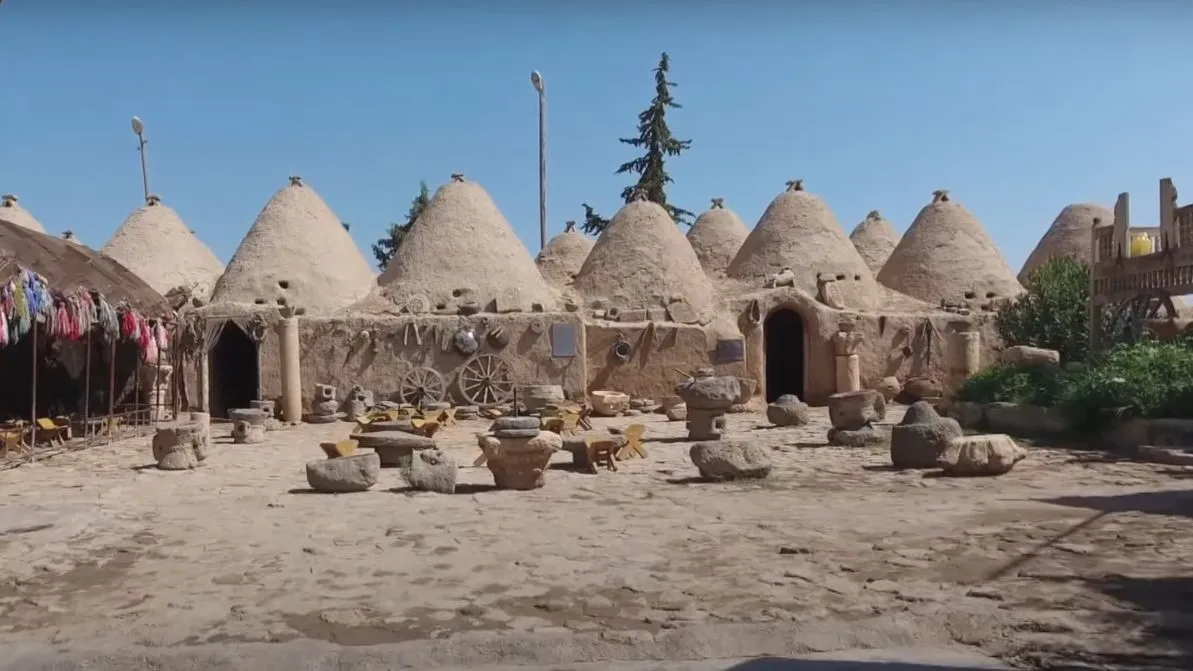
The construction of the trulli is the result of ancient knowledge of the Apulian Murgia, handed down from father to son for generations.
Building dry, without lime, with stone upon stone, is the striking manifestation of the peasant ability to bend this impervious land to their own needs.
Visitors on holiday in Alberobello will find themselves surrounded by whitewashed old houses, dazzling in the summer sun, with conical roofs decorated with mysterious white inscriptions.
Trulli of Alberobello: extraordinary example of spontaneous popular architecture
Originally the Trulli were huts that were born isolated on the edge of a wood and slowly began to be connected by roads arranged in a district to form an entire town.
Alberobello is an exceptional case of dry stone architecture that is organized in an urban form.
In the past it was asked whether this way of living was not an obstacle to the development, progress and improvement of the living conditions of the population.
These same questions were put to the hearing of the world and the world suggested that we continue to carve these white stones and protect the houses they were built with.
In these conical buildings that stand out in the sky, the Trulli of Alberobello, there are universal values to be preserved for the time to come.
Alberobello is an Italian unesco world heritage site, a world heritage for Italy and a heritage for the world.
Curiosities about Alberobello
€ 45.5
One of the most heartfelt legends concerns the Siamese Trullo. Legend has it that the Siamese Trullo was inhabited by two brothers.
The betrothed of the elder brother fell in love with the other brother, becoming lovers.
Coexistence became unbearable. So the elder brother in anger chased the two lovers out of the house.
However, both brothers claimed the right to inherit the trullo. And then the structure was divided into two areas.
Alberobello has been a film set several times
The Apulian village of Alberobello has been a film set several times. In particular we remember two of the most famous films:
- In the summer of 2010, the blockbuster Italian film What a Beautiful Day was shot with Checco Zalone.
- In May 2012, some episodes of the American series Beautiful were shot.
What are you waiting for? Book your next holiday in Puglia and visit this beautiful village. Alberobello is rich in history, art and beauty.
Particularly suggestive is the visit of Alberobello during the Christmas period or durig the Christmas market in Alberobello.The town is filled with lights and colors. It is wonderful to walk through the alleys where you can find the trulli illuminated by Christmas lights projected on the buildings.
It creates a decidedly magical atmosphere.

Alberobello Trulli, discover the mysterious symbols drawn on the roofs
On the trulli we find symbols that in the forties were cataloged in more than two hundred.
Understanding exactly what the meaning was was not possible.
There are those who think they are superstitions related to the good health of the family or to the removal of troubles or to the protection from the disease and the thanksgiving of the gods.
Unfortunately, there is no certainty of all this because everything has been handed down orally for centuries and the original meaning has been lost.
The cone-shaped roof carried out the function of collecting rainwater which was directed to special cisterns located in the girth of the trullo and which allowed families to have an autonomous water supply.
Alberobello Trulli: the ancient biblical origins and the latest discoveries
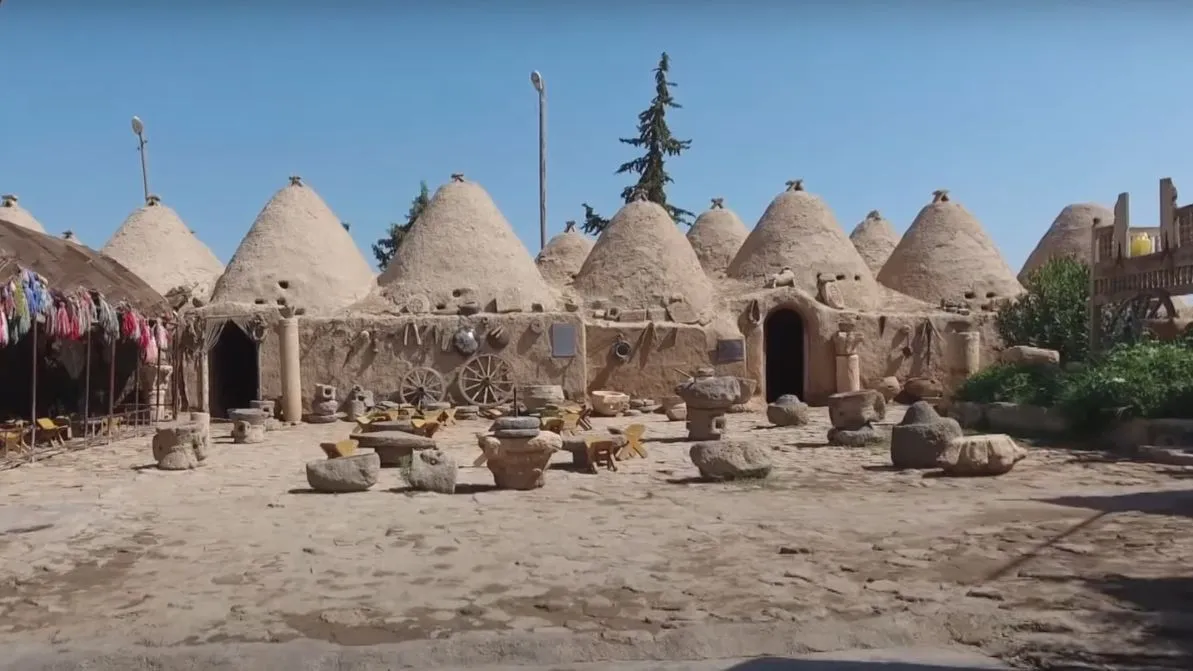
A trullo is a traditional dry stone construction with a conical roof.
Recent studies and discoveries hypothesize the ancient origin of these constructions from Turkey, with a hypothesis of even biblical origin.
It has in fact been noted that the ancient buildings widespread in general in the Alberobello area, the Trulli, closely resemble the mud buildings of a biblical place in ancient Turkey or the ancient Haran or Charan, today Carran.
Haran is an ancient city whose ruins are in present-day Turkey about twenty kilometers from the Syrian border in the east.
Haran was the original city of Abraham and from there began the journey to the promised land, which is present-day Palestine.
A thousand years ago Abraham's descendants returned to the old city of Chanaan which today is called Haran, in Turkey, to rebuild it.
In the same period a part of those populations descended from Abraham moved to the territories of Puglia settling between Bari and Taranto.
It was in that period that the link between the Trulli and the ancient biblical traditions was born: the moment in which an architectural form was chosen in Alberobello that could in some way recall the territory of Syrian Palestinian origin.
On that occasion, most likely, it is thought that the shape and concept of the trullo may have reached the territory of Alberobello.
These are the reasons why the Trullo would have these biblical origins but there is more.
The origins of the symbols found on the trulli are surprisingly similar to the symbols found in some Egyptian burials, also similar to other burials found near Alberobello in the village of Egnazia, a city built near the water and perhaps even destroyed by the water.
In fact, only the remains of Egnazia can be seen near the coast, not far from Alberobello, and a part of the city is in fact submerged by the Adriatic Sea.
